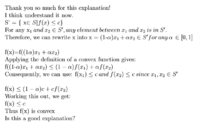Hello,
I got an assignment I have to prove, but I am a bit stuck on how to continue.
The assignment:
A function [MATH]f: F \to \mathbb{R} [/MATH] is convex if and only if its sublevel set {x∈S|f(x)≤c} is a convex set for any c.
Convex theorem:
[MATH]f((1-\alpha)x_1 + \alpha x_2) \le (1-\alpha)f(x_1) + \alpha f(x_2)\\ for \\alpha \in [0,1]\\ x_1, x_2 \in S[/MATH]
My try:
[MATH]f(x) \le c\\ x = (1-\alpha)x_1 + \alpha x_2\\ f(x) = f((1-\alpha)x_1 + \alpha x_2)\\ f(x) \le (1-\alpha)f(x_1) + \alpha f(x_2)\\ f(x) \le (1-\alpha)c + \alpha c\\ f(x) = c [/MATH]
Am I missing something?
Could someone give me a clear explanation of the steps, since I don't fully understand it all.
Thank you in advance!
I got an assignment I have to prove, but I am a bit stuck on how to continue.
The assignment:
A function [MATH]f: F \to \mathbb{R} [/MATH] is convex if and only if its sublevel set {x∈S|f(x)≤c} is a convex set for any c.
Convex theorem:
[MATH]f((1-\alpha)x_1 + \alpha x_2) \le (1-\alpha)f(x_1) + \alpha f(x_2)\\ for \\alpha \in [0,1]\\ x_1, x_2 \in S[/MATH]
My try:
[MATH]f(x) \le c\\ x = (1-\alpha)x_1 + \alpha x_2\\ f(x) = f((1-\alpha)x_1 + \alpha x_2)\\ f(x) \le (1-\alpha)f(x_1) + \alpha f(x_2)\\ f(x) \le (1-\alpha)c + \alpha c\\ f(x) = c [/MATH]
Am I missing something?
Could someone give me a clear explanation of the steps, since I don't fully understand it all.
Thank you in advance!


